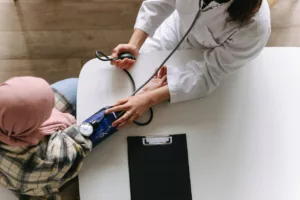Technology is changing all aspects of modern medicine. Today’s doctors are using technology to track recoveries, offer support after surgery, and increase communication with their patients.
By leveraging technology in patient engagement tools, doctors are increasingly connecting with their patients in a way we have never seen before – and it’s a move that seems to be paying dividends.
What is Patient Engagement Technology?
Patient engagement is the process of enabling patients to become “partners” in their own recovery. It’s all about empowering patients to contribute to their personal recovery. Patient engagement technology is the ability to connect to patients using digital platforms and tools.

Benefits of Patient Engagement
Healthcare Information and Management Systems Society (HIMSS) defines patient engagement as, “the ongoing and constructive dialogue between patient and practitioner.”
More and more it seems this constructive dialogue works. Patients who take an active role in the recovery process, and are kept up-to-date before any procedure, are more likely to have a better outcome than those who don’t. Patient engagement ensures the patients themselves are critical players in their return to good health.
This is great news for the patients, surgeons, and surgical practices. Clinics don’t want to see patients returning due to complications after surgery as they face being penalized with reduced levels of reimbursements for high levels of readmission.
Anything that can be done to cut down on the number of unhappy and unsatisfied patients post-surgery should be embraced. While patient engagement covers a broad range of approaches and practices, they all put the patient front and center.
Patient Engagement Tools

Here are five of the best patient engagement tools for practices that can greatly enhance communication with patients:
1. Patient Portals
If information is king, then a patient portal can make royalty out of anyone who knows how to access a website. Portals like MyChart are secure online sites that allow patients to access their personal health information without calling the doctor or bothering a receptionist for paperwork. Using a secure username and password, patients have access to helpful information, such as:
- Recent visits
- See lab results
- Find lists of their medications
Depending on the site, some portals also allow patients to:
- Request prescription refills
- Email their healthcare providers
- Schedule appointments
2. Mobile Applications

Mobile apps are becoming more and more prevalent as effective digital patient-engagement tools. Apps can be used in many ways, including:
- Educating patients pre-surgery
- Assisting with the recovery process
- Dosage trackers
- Exercise reminders
Apps take some of the stress and pressure off the patients. They don’t have to remember everything about their recovery — it’s all there in the app. Understandably, this can go a long way to reducing stress, which helps in the recovery process.
The Patient Journey App is a communication platform that gives patients and their families all the information they need from pre-surgery throughout the recovery process.
However, there is a caveat: While technology absolutely has its place in healthcare and in patient engagement, physicians and managers must consider their patient demographic before deciding what and how much technology they want to introduce into the practice.
If a surgeon primarily sees older patients, they are probably not the best audience for a high-tech app. With any potential new tool, be sure to consider the patient first. If not, you might find that patients become disengaged rather than increasingly engaged in their healthcare journey.
3. Patient-Generated Health Data (PGHD)
While physicians and other healthcare professionals are the ones keeping track of, well, everything, there’s only so much information they can get from a short visit.

PGHD supports and supplements existing clinical data and can fill in some important gaps. It allows doctors to understand how patients are doing in between visits and provides long-term or wider-ranging data rather than only what is observed in the exam room.
Some examples of useful data and apps that can give doctors a bigger picture of patients’ overall health are:
- OneTouch Reveal: Tracks glucose levels (particularly important for diabetic patients)
- iBP Blood Pressure: Blood pressure tracking and analysis tool
- MTBC Personal Health Records: Manages patients’ health records such as lab results and X-rays
Although there are a range of apps to help record critical information, patients or caregivers can also do it the old-fashioned way — by writing down any important details. As long as anything important is brought to the physician’s or surgeon’s attention.
4. Secure Messaging
When providing patients with communication channels with their doctors, it’s critical that both parties use secure systems that are HIPAA compliant. Secure messaging enables patients to be in contact with medical professionals for questions or concerns.
Companies like Mimecast provide HIPAA-compliant messaging platforms that protect patients’ privacy.

5. Using Your Existing Tools For Patient Engagement
Along with these four key areas, don’t underestimate the power of your existing EMR or other scheduling workflow platforms such as Surgimate when it comes to patient engagement.
Surgimate, for example, can generate all the relevant surgical data to help clinicians track their patients’ progress post-surgery, and share this information with any necessary third parties. It also stores all notes and communication, giving up-to-the-moment access on where the patient is in the recovery process.
Implementing Patient Engagement Technologies
As patient engagement becomes an increasingly important part of the medical process, there will undoubtedly be an influx of tools, systems, and platforms. All of these additions will ensure patients are no longer just another file to get through, but they are, rightly, important players in tracking their own good health.
- Sari Nossbaumhttps://www.surgimate.com/author/sari/
- Sari Nossbaumhttps://www.surgimate.com/author/sari/
- Sari Nossbaumhttps://www.surgimate.com/author/sari/
- Sari Nossbaumhttps://www.surgimate.com/author/sari/




